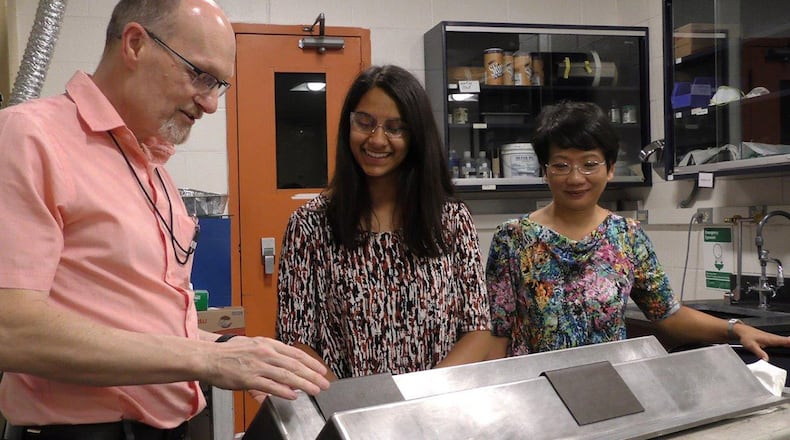She revealed that many former Wright Scholars eventually return to Wright-Patterson Air Force Base for full-time employment.
The Wright Scholar Program is a nine-week internship for high school students interested in STEM (science, technology, engineering and mathematics). Since 2002, 575 students from 88 school districts have completed the program with 91 percent going on to pursue careers in STEM.
The program is open to juniors and seniors in high school who are at least 16 years of age and have a GPA of 3.5 or higher. Depending on the budget, 45 to 60 students are chosen each year in a blind review by a panel of scientists, engineers and educators. The students selected are placed in a technology directorate and assigned an AFRL mentor. Based on feedback from mentors, students can be invited back for a second year.
First-Year Wright Scholars
Alison Bachowski, a high school senior from Springfield, received not one but three offers for summer internships. She selected AFRL over Johns Hopkins and Harvard University. Bachowski tested the accuracy of a device that monitors heart rate. She conducted experiments at the Wright Field Fitness Center with participants running on treadmills wearing temple sensors and biometric shirts, which have sensors woven into the fabric. The 711th Human Performance Wing is testing various physiological monitoring devices for Air Force pilots to wear while in flight.
Catherine Mohs, a home-schooled student from Xenia, assisted a Ph.D. candidate in the Aerospace Systems Directorate with his research project. She studied phase change testing in gallium, an element that prevents electronic systems from overheating and failing on aircraft.
After her first full day in the lab, Mohs wondered if she was ready for such a challenging assignment. She explained that as soon as she started learning about the lab equipment, she was so busy concentrating on tasks that she forgot all about her fear. But suddenly, the realization hit her. She was no longer anxious. Instead, she felt extremely excited.
“I took a moment to realize how awesome this all was. This was a dream job for me,” she said. “How often do [people] get to try out their dream job?”
Second-Year Wright Scholars
Jasmine Hughes, a graduate of Chaminade Julienne High School worked in the composites laboratory of the Materials and Manufacturing Directorate. She evaluated high-temperature polyimide resins and applied composite processing and characterization techniques. The Air Force uses composite materials in aircraft parts since they are lightweight and durable.
Hughes first visited the laboratory during a job shadow day not knowing she would one day work there. Thao Gibson, her tour guide and future mentor noted that, “she asked all sorts of questions about the equipment and what we do here in the lab.”
Their paths would cross again when Gibson agreed to host a Wright Scholar intern.
“I recognized her right way,” Gibson said of Hughes. “I knew who she was: that girl that asked all the questions. I knew she would be good in the lab here.”
Gibson’s instinct was on target. She said Hughes is “a natural at research” and described her as curious and hardworking.
Jacob Eaton, a recent graduate from Miamisburg High School, worked within the Aerospace Systems Directorate under the guidance of Aerospace Engineer Brock Pleiman. Eaton interacted with Aerodynamic Interface Planes that measure pressure recovery in the wind tunnel.
When asked to serve as a mentor, Pleiman said that he reflected on his own experience as an intern.
“I was hesitant to ask questions since there was no one close to my age,” he said. “They were all older with decades of engineering experience, so it was rather intimidating. It’s much easier to approach someone who is closer in age to you.”
Eaton said that he is grateful to his mentor for translating complex material into simple terms that he could easily understand.
Andrew Haberlandt developed code for a software project involving an artificial intelligence system. The recent graduate of Bellbrook High School gained valuable skills working with a software team in the Sensors Directorate.
“It was very rewarding to see code I wrote being incorporated into a larger project and contributing toward a larger goal,” he said.
Haberlandt was mentored by Benjamin Heiner, who he described as instrumental to his positive experience.
“The immersion into the project team was invaluable,” he said. “I am thankful that my mentor shaped my internship into such a meaningful learning experience.”
Former Wright Scholar
Zachary Adamson, a student at Ohio State University, is now a contractor within the Aerospace Systems Directorate. After two summers in the Wright Scholar Program, PC Krause and Associates hired Adamson based on a recommendation from his mentor. In his current job, he works on modeling and simulation of aircraft power and thermal management systems.
About the Author
